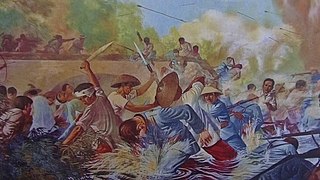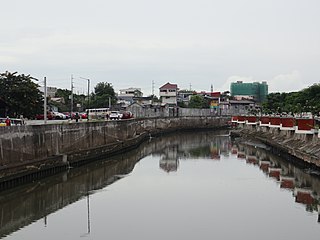
Emilio Aguinaldo y Famy was a Filipino revolutionary, statesman, and military leader who is officially recognized as the first and the youngest president of the Philippines (1899–1901) and the first president of a constitutional republic in Asia. He led Philippine forces first against Spain in the Philippine Revolution (1896–1898), then in the Spanish–American War (1898), and finally against the United States during the Philippine–American War (1899–1901).
The military history of the Philippines is characterized by wars between Philippine kingdoms and its neighbors in the precolonial era and then a period of struggle against colonial powers such as Spain and the United States, occupation by the Empire of Japan during World War II and participation in Asian conflicts post-World War II such as the Korean War and the Vietnam War. The Philippines has also battled a communist insurgency and a secessionist movement by Muslims in the southern portion of the country.

Bacoor, officially known as the City of Bacoor, is a 1st class component city in the province of Cavite, Philippines. According to the 2020 census, it has a population of 664,625 people, making it the 15th most populous city in the Philippines and the second largest city in the province of Cavite after Dasmariñas.
Battle of the Philippines may refer to several wars, military campaigns, and major battles which have been fought in the Philippine Islands, including:

The Battle of Zapote River, also known as the Battle of Zapote Bridge, was fought on the 13 June 1899 between 1,200 Americans and between 4,000~5,000 Filipinos. It was the second largest battle of the Philippine–American War after the Battle of Manila five months before in February 1899. Zapote River separates the town of Las Piñas in what was then Manila province from Bacoor in the province of Cavite. The ruins of Zapote Bridge still stands next to its replacement bridge on Aguinaldo Highway.

Miguel Malvar y Carpio was a Filipino general who served during the Philippine Revolution and, subsequently, during the Philippine–American War. He assumed command of the Philippine revolutionary forces during the latter, following the capture of resistance leader Emilio Aguinaldo by the Americans in 1901. According to some historians, he could have been listed as one of the presidents of the Philippines but, as of 2022, is not recognized as such by the Philippine government.

The Battle of Manila, the first and largest battle of the Philippine–American War, was fought on February 4–5, 1899, between 19,000 American soldiers and 15,000 Filipino armed militiamen. Armed conflict broke out when American troops, under orders to turn away insurgents from their encampment, fired upon an encroaching group of Filipinos. Philippine President Emilio Aguinaldo attempted to broker a ceasefire, but American General Elwell Stephen Otis rejected it and fighting escalated the next day. It ended in an American victory, although minor skirmishes continued for several days afterward.
The Philippine–American War, also known as the Philippine War of Independence or the Philippine Insurrection (1899–1902), was an armed conflict between Filipino revolutionaries and the government of the United States which arose from the struggle of the First Philippine Republic to gain independence following the Philippines being acquired by the United States from Spain. This article lists significant events from before, during, and after that war, with links to other articles containing more detail.

The Philippine Republic, now officially known as the First Philippine Republic, also referred to by historians as the Malolos Republic, was established through the promulgation of the Malolos Constitution on January 22, 1899, in Malolos, Bulacan during the Philippine Revolution and the Spanish–American War, succeeding the Revolutionary Government of the Philippines. It was formally established with Emilio Aguinaldo as president. It maintained governance until April 1, 1901.

Francisco Carreón y Marcos was a Filipino general in the Philippine Revolution against Spain and in the Philippine–American War. As the vice president of Macario Sakay's Tagalog Republic (Tagalog: Republika ng Katagalugan), he continued resistance against the United States up until the dissolution of the republic in 1906. He was captured on July 14, 1906 and was imprisoned in the old Bilibid Prison; he was later released in 1930 through a pardon.

The Battle of Zapote Bridge was fought on February 17, 1897, as part of the Philippine Revolution. Filipino revolutionary forces led by General Emilio Aguinaldo defeated Spanish forces under the command of Governor-General Camilo de Polavieja. In this battle, General Edilberto Evangelista was killed.

Fighting erupted between forces of the United States and those of the Philippine Republic on February 4, 1899, in what became known as the 1899 Battle of Manila. On June 2, 1899, the First Philippine Republic officially declared war against the United States. The war officially ended on July 2, 1902, with a victory for the United States. However, some Philippine groups—led by veterans of the Katipunan, a Philippine revolutionary society—continued to battle the American forces for several more years. Among those leaders was General Macario Sakay, a veteran Katipunan member who assumed the presidency of the proclaimed Tagalog Republic, formed in 1902 after the capture of President Emilio Aguinaldo. Other groups, including the Moro, Bicol and Pulahan peoples, continued hostilities in remote areas and islands, until their final defeat at the Battle of Bud Bagsak on June 15, 1913.
The following lists events that happened during 1899 in the Philippine Republic.
This is a list of notable events that happened in the Philippines in the year 1897.

Historical markers are installed by the National Historical Commission of the Philippines (NHCP) in the Philippines and places abroad that signify important events, persons, structures, and institutions in Philippine national and local histories. The plaques themselves are permanent signs installed by the NHCP in publicly visible locations on buildings, monuments, or in special locations. Local municipalities and cities can also install markers of figures and events of local significance. Though they may have the permission of the NHCP, these markers are barred from using the seal of the Republic of the Philippines.

The Bridge of Isabel II is a historic bridge in the City of Imus in Cavite province, Philippines. The two-span stone arch bridge that was completed in 1857 was the site of the Battle of Imus, also known as the Battle of Imus River, on September 3, 1896 between the Filipino revolutionaries and the soldiers of the Spanish colonial government.

The San Juan River Bridge, also known as Pinaglabanan Bridge, San Juan del Monte Bridge, San Juan Bridge and the Old Santa Mesa Bridge, is a bridge that connects San Juan and Manila, spanning the San Juan River. The 46.85-meter (153.7 ft) bridge connects the N. Domingo Street in San Juan and Old Santa Mesa Street in Manila. The location of the bridge served as a battlefield during the 1896 Philippine Revolution against the Spaniards and the 1899 Philippine–American War.

Padre Diego Cera Avenue, or simply Diego Cera Avenue, is a major north-south collector road in Las Piñas, Metro Manila, Philippines. It is a four-lane undivided arterial running parallel to the Manila–Cavite Expressway to the west from Manuyo Uno at Las Piñas' border with Parañaque in the north to Zapote near the border with Bacoor in the south. It is a continuation of Elpidio Quirino Avenue from Parañaque and was originally a segment of Calle Real in Las Piñas. The road is a component of the National Route 62 (N62) of the Philippine highway network and Radial Road 2 (R-2) of Manila's arterial road network.

The following outline is provided as an overview of and topical guide to Metro Manila:

The Zapote River, also referred to as the Alabang–Zapote River, is a river in the Philippines located between the boundaries of the cities of Las Piñas and Muntinlupa in Metro Manila, Bacoor and Dasmariñas in Cavite, and San Pedro in Laguna. The river has a total length of 5.81 kilometers (3.61 mi).




















